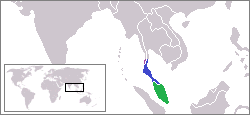|
Preah Maha Ghosananda
Maha Ghosananda (full title Samdech Preah Maha Ghosananda - km, សម្តេចព្រះមហាឃោសានន្ទ; pi, Mahāghosānanda; May 23, 1913 – March 12, 2007) was a highly revered Cambodian Buddhist monkAsiaweek August 31, 1999 at in the tradition, who served as the Patriarch (Sangharaja) of Cambodian Buddhism during the Khmer Rouge period and post-communist transition period of Cambodian history. [...More Info...] [...Related Items...] OR: [Wikipedia] [Google] [Baidu] |
His Holiness
The title His Holiness (and the associated form of address Your Holiness) is an official title or style referring to the pope; this use can be traced back several hundred years. It is also an official title for Oriental Orthodox patriarchs or Catholicoi. The title is also used by other religious leaders such as Lu Sheng-yen, the Dalai Lama, the Menri Trizin, and Da'i al-Mutlaq of the Dawoodi Bohras, etc. Christianity Catholic Church ''His Holiness'' ( lat, Sanctitas) is the official style used to address the Roman Catholic pope. The full papal title, rarely used, is: : ''His Holiness (Francis), Bishop of Rome, Vicar of Jesus Christ, Successor of the Prince of the Apostles, Supreme Pontiff of the Universal Church, Primate of Italy, Archbishop and Metropolitan of the Roman Province, Sovereign of the Vatican City State, Servant of the servants of God.'' The best-known title, that of "Pope", does not appear in the official list of titles, but is commonly used in ... [...More Info...] [...Related Items...] OR: [Wikipedia] [Google] [Baidu] |
Sangharaja
Sangharaja (Pāli: ''sangha'' religious community + ''raja'' ruler, king, or prince) is the title given in many Theravada Buddhist countries to a senior monk who is the titular head either of a monastic fraternity ( nikaya), or of the ''Sangha'' throughout the country. This term is often rendered in English as 'Patriarch' or 'Supreme Patriarch'. Overview The position of ''sangharaja'' has been assigned according to various methods in different countries and time periods. In some cases, the sangharaja is determined by absolute monastic seniority; the sangharaja is the monk who has spent the most rains retreats (vassa) as a monk. In other cases, royal appointment may play a role- the sangharaja may be appointed by the king, particularly in Southeast Asian countries where the monarchy is closely associated with Buddhism (Thailand, for example). Alternatively, the ''sangharaja'' may be chosen semi-democratically by monks or the laity (similar to the election of an abbot in some T ... [...More Info...] [...Related Items...] OR: [Wikipedia] [Google] [Baidu] |
Sa Kaeo Refugee Camp
Sa Kaeo Refugee Camp (also referred to as Sa Kaeo I or Ban Kaeng) was the first organized refugee relief camp established on the Thai-Cambodian border. It was built by the Royal Thai Government with support from international relief agencies including the United Nations. It opened in October 1979 and closed in early-July 1980. At its peak the population exceeded 30,000 refugees; no formal census was ever conducted. Origins of the Cambodian refugee crisis Vietnam invaded Democratic Kampuchea in December 1978 and by early-1979 thousands of Cambodians had crossed the Thai-Cambodian border seeking safety and food. By May 1979 large numbers of refugees had set up improvised camps at Kampot, Mairut, Lumpuk, Khao Larn, and Ban Thai Samart, near Aranyaprathet. In June, 42,000 Khmer refugees were pushed back into Cambodia by the Thai Royal Army in what was known as the Dangrek genocide, which sparked international outrage and was discussed in July 1979 during an international conference ... [...More Info...] [...Related Items...] OR: [Wikipedia] [Google] [Baidu] |
Refoulement
Non-refoulement () is a fundamental principle of international law that forbids a country receiving asylum seekers from returning them to a country in which they would be in likely danger of persecution based on "race, religion, nationality, membership of a particular social group or political opinion". Unlike political asylum, which applies to those who can prove a well-grounded fear of persecution based on certain category of persons, non-refoulement refers to the generic repatriation of people, including refugees into war zones and other disaster locales. It is a principle of customary international law, as it applies even to states that are not parties to the 1951 Convention Relating to the Status of Refugees or its 1967 Protocol. It is also a principle of the trucial law of nations. It is debatable whether non-refoulement is a ''jus cogens'' of international law. If so, international law would permit no abridgments for any purpose or under any circumstances. The debate over th ... [...More Info...] [...Related Items...] OR: [Wikipedia] [Google] [Baidu] |
Royal Thai Government
The Government of Thailand, or formally the Royal Thai Government ( Abrv: RTG; th, รัฐบาลไทย, , ), is the unitary government of the Kingdom of Thailand. The country emerged as a modern nation state after the foundation of the Chakri Dynasty and the city of Bangkok in 1782. The Revolution of 1932 brought an end to absolute monarchy and replaced it with a constitutional monarchy. From then on the country was ruled by a succession of military leaders installed after coups d'état, the most recent in May 2014, and a few democratic intervals. The 2007 Constitution (drafted by a military-appointed council, but approved by a referendum) was annulled by the 2014 coup-makers who ran the country as a military dictatorship. Thailand has so far had seventeen Constitutions. Throughout, the basic structure of government has remained the same. The government of Thailand is composed of three branches: the executive, the legislative, and the judiciary. The system of go ... [...More Info...] [...Related Items...] OR: [Wikipedia] [Google] [Baidu] |
Peter L
Peter may refer to: People * List of people named Peter, a list of people and fictional characters with the given name * Peter (given name) ** Saint Peter (died 60s), apostle of Jesus, leader of the early Christian Church * Peter (surname), a surname (including a list of people with the name) Culture * Peter (actor) (born 1952), stage name Shinnosuke Ikehata, Japanese dancer and actor * ''Peter'' (album), a 1993 EP by Canadian band Eric's Trip * ''Peter'' (1934 film), a 1934 film directed by Henry Koster * ''Peter'' (2021 film), Marathi language film * "Peter" (''Fringe'' episode), an episode of the television series ''Fringe'' * ''Peter'' (novel), a 1908 book by Francis Hopkinson Smith * "Peter" (short story), an 1892 short story by Willa Cather Animals * Peter, the Lord's cat, cat at Lord's Cricket Ground in London * Peter (chief mouser), Chief Mouser between 1929 and 1946 * Peter II (cat), Chief Mouser between 1946 and 1947 * Peter III (cat), Chief Mouser between ... [...More Info...] [...Related Items...] OR: [Wikipedia] [Google] [Baidu] |
Nakhon Si Thammarat
Nakhon Si Thammarat Municipality ( th, เทศบาลนครนครศรีธรรมราช, ; from Pali ''Nagara Sri Dhammaraja'') is a municipality (''thesaban nakhon'') in Southern Thailand, capital of Nakhon Si Thammarat province and Mueang Nakhon Si Thammarat district. It is about south of Bangkok, on the east coast of the Malay Peninsula. The city was the administrative center of southern Thailand during most of its history. Originally a coastal city, silting moved the coastline away from the city. The city has a much larger north to south extension than west to east, which dates back to its original location on a flood-save dune. The modern city centre on the train station is north of Old Town. As of 2019, the city had a population of 102,152. Toponymy Thai honorific ''Sri'' or ''Si'' is from Sanskrit Sri; , from Dharma; , from Raja. ''Dhammaraja'' means "righteous ruler", an important Theravada concept. History Nakhon Si Thammarat is one of the o ... [...More Info...] [...Related Items...] OR: [Wikipedia] [Google] [Baidu] |
Thai Forest Tradition
The Kammaṭṭhāna Forest Tradition of Thailand (from pi, kammaṭṭhāna meaning "place of work"), commonly known in the West as the Thai Forest Tradition, is a lineage of Theravada Buddhist monasticism. The Thai Forest Tradition started around 1900 with Ajahn Mun Bhuridatto, who wanted to practice Buddhist monasticism, and its meditative practices, according to the normative standards of pre-sectarian Buddhism. After studying with Ajahn Sao Kantasīlo and wandering through the north-east of Thailand, Ajahn Mun reportedly became a non-returner and started to teach in North-East Thailand. He strived for a revival of the Early Buddhism, insisting on a strict observance of the Buddhist monastic code, known as the Vinaya, and teaching the practice of '' jhāna'' and the realisation of ''nibbāna''. Initially, Ajahn Mun's teachings were met with fierce opposition, but in the 1930s his group was acknowledged as a formal faction of Thai Buddhism, and in the 1950s the rel ... [...More Info...] [...Related Items...] OR: [Wikipedia] [Google] [Baidu] |
Ajahn Lee
Phra Suddhidhammaransi Gambhiramedhacarya (1907–1961), commonly known as Ajahn Lee Dhammadharo, was a meditation teacher in the Thai Forest Tradition of the Dhammayuttika Nikaya order of Theravada Buddhism. He was born in the Ubon Ratchathani Province of Isan and was a student of Mun Bhuridatta. Ajahn Lee is regarded as one of the greatest teachers and meditation masters of the Thai Forest Tradition of the 20th century. Among the forest monks, he devised the most comprehensive meditation instructions, and composed the most detailed map of the jhānas. He was one of the first teachers to bring the teachings of the Forest Tradition to the mainstream of Thai society. He never spoke of his own meditative attainments, however it was widely discussed among his students that he may have had psychic powers. Biography Ajahn Lee first attended school at age twelve, and left school at age seventeen. At this time, he was preoccupied with earning money, and had a plan for his early life wh ... [...More Info...] [...Related Items...] OR: [Wikipedia] [Google] [Baidu] |
Buddhist Meditation
Buddhist meditation is the practice of meditation in Buddhism. The closest words for meditation in the classical languages of Buddhism are ''bhāvanā'' ("mental development") and '' jhāna/dhyāna'' (mental training resulting in a calm and luminous mind). Buddhists pursue meditation as part of the path toward liberation from defilements ('' kleshas'') and clinging and craving (''upādāna''), also called awakening, which results in the attainment of Nirvana, and includes a variety of meditation techniques, most notably ''anapanasati'' (mindfulness of breathing). Other techniques include '' asubha bhavana'' ("reflections on repulsiveness");Deleanu, Florin (1992)Mindfulness of Breathing in the Dhyāna Sūtras Transactions of the International Conference of Orientalists in Japan (TICOJ) 37, 42-57. reflection on '' pratityasamutpada'' (dependent origination); ''anussati'' (recollections, including ''anapanasati'') and ''sati'' (mindfulness), culminating in ''dhyana'' (developin ... [...More Info...] [...Related Items...] OR: [Wikipedia] [Google] [Baidu] |
Mahatma Gandhi
Mohandas Karamchand Gandhi (; ; 2 October 1869 – 30 January 1948), popularly known as Mahatma Gandhi, was an Indian lawyer, anti-colonial nationalist Quote: "... marks Gandhi as a hybrid cosmopolitan figure who transformed ... anti-colonial nationalist politics in the twentieth-century in ways that neither indigenous nor westernized Indian nationalists could." and political ethicist Quote: "Gandhi staked his reputation as an original political thinker on this specific issue. Hitherto, violence had been used in the name of political rights, such as in street riots, regicide, or armed revolutions. Gandhi believes there is a better way of securing political rights, that of nonviolence, and that this new way marks an advance in political ethics." who employed nonviolent resistance to lead the successful campaign for India's independence from British rule, and to later inspire movements for civil rights and freedom across the world. The honorific '' Mahātmā'' (Sanskr ... [...More Info...] [...Related Items...] OR: [Wikipedia] [Google] [Baidu] |



